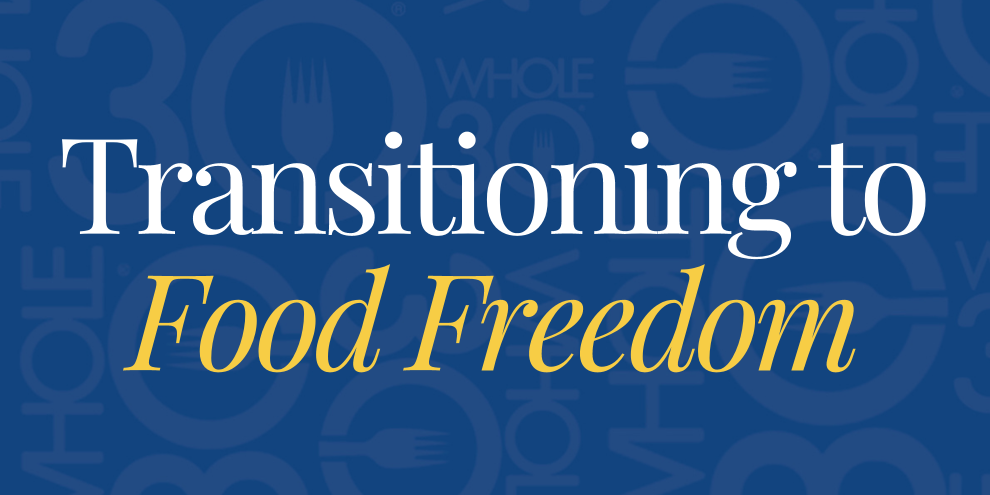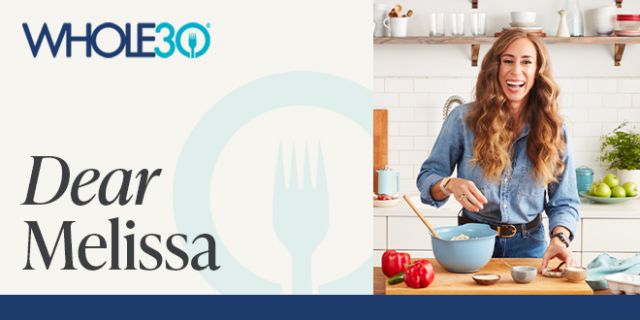Congratulations, Whole30 alumni! You’ve completed 30 days of elimination, checked off a whole host of Non-Scale Victories, and worked through your carefully planned reintroduction phase. During reintroduction, you brought back the foods and food groups you’ve been missing, paying attention to how they affected your cravings and mood, blood sugar and energy, sleep, digestion, inflammation, and other symptoms.
By comparing your experience during elimination (without these foods in your diet) to how you felt when you reintroduced them, you’ve gained important insights as to how well (or not well) these foods work in your unique body. Now, it’s time to use those insights to create your own personalized, sustainable, joyful Food Freedom plan.
In Food Freedom Forever, you’ll find everything you need to take your Whole30 learnings into your food freedom in a way that serves your health, lifestyle, and goals. Today, we’ll highlight three tips that will help you make the most of your Whole30 reintroduction and start to build your Food Freedom plan.
Tip 1: Reintroduction is a life-long process
During Original Whole30 or Plant-Based reintroduction, you have a unique opportunity to bring foods back into your diet in a controlled fashion. First, you’ll head into reintroduction coming off 30 straight days of elimination, which leaves you feeling your Whole30-best. Second, you’ll keep the rest of your meals Whole30-compatible during reintroduction days, so the reintroduced food groups are the only experimental factor. This allows you to clearly see the impact of these foods on all of your body’s systems.
However, reintroduction doesn’t end when those 10 days are over. Every time you include added sugar, alcohol, grains, or other elimination foods in your meals, pay attention to how they impact you, and build those learnings into your Food Freedom plan too.
You may discover that during reintroduction, a day of gluten didn’t have much of an impact—but in your food freedom, three days in a row leaves you bloated, breaking out, and moody. That’s important intel! You also may find that during reintroduction, dairy left you bloated and gassy, but with repeated inclusion in your diet, you’re able to more effectively digest cheese and yogurt. That’s equally important!
Your body, health, context, and goals are always changing—and so will your Food Freedom plan. Continue to pay attention to the way food impacts you even after reintroduction ends.
Tip 2: Keep asking, “Is it worth it?”
We encourage you not to extrapolate one set of reintroduction results into infinity, making assumptions about whether it’s worth it (or if you even want it) in your food freedom. During one of my first Whole30 reintroductions, the one glass of wine I had with dinner was totally worth it. Yes, I slept poorly and woke up with a headache, but that night, the joy of sipping on my favorite red was far greater than the next day’s consequences.
I made the mistake, however, of thinking, “Great, a glass (or two) of wine will always be worth it!” I started drinking wine more often just because I could, and I stopped paying close attention to how it made me feel. Soon—far too soon—I started feeling sluggish, tired, and cranky. The problem, I realized, was the alcohol. It was worth it that one night in that specific context, but that didn’t mean wine would always be worth it!
I began asking myself before every potential drink, “Will this glass in this context be worth it? And do I even want it?” Sometimes I answered, “Yes, and yes” conscientiously. But more often than not, the answer was, “No, and no.” Before I knew it, I was back to feeling Whole30-good, and didn’t miss the wine at all (because it was my decision to pass).
Wine might be worth it on vacation with friends, but not on a random Tuesday after work at home by yourself. Gluten might be worth it when your mom bakes chocolate chip cookies, but not when it’s a bag of Chips Ahoy left on the break room counter. Sugar might be worth it in your morning coffee, but not in a soda. The key to your Food Freedom plan is always asking those two questions and using your reintroduction learnings (during your official reintroduction period and in your Food Freedom) to help you answer in a way that’s right for that moment.
Tip 3: “Is it worth it?” is always up to you
Our last tip is more of a permission slip, because there are still some misconceptions about life after the Whole30. Food freedom isn’t about learning how to say no. It’s about confidently saying yes when it’s worth it, and happily choosing to pass when it isn’t. And only you can decide whether a food or drink is worth it for you.
Say your reintroduction shows you that dairy does a number on your digestion—gas, bloating, stomach pain, diarrhea, the works. But you love ice cream. It’s your favorite food, your most special treat, and the one thing you look forward to the most during a day out with your family or a summer vacation.
Reintroduction isn’t designed to convince you to never eat ice cream again. No matter the consequences, you get to make that decision for yourself.
What reintroduction can show you, however, is the quantity, frequency, variety, and context in which you may be able to continue eating these foods you love while minimizing any negative effects. And again, because reintroduction is a life-long process, you’ll have a lot of opportunities to play around with these factors!
Perhaps full-fat ice cream settles better in your stomach than “light” ice cream. Perhaps you enjoy a coconut or almond milk ice cream just as much as the real deal, and that becomes your “worth it” substitute. Maybe you discover that with a little planning and some Lactaid, you can enjoy a cup or a cone with minimal digestive distress.
Or maybe, you decide on occasion that ice cream is worth it, damn the consequences—so you make a deliberate decision to eat it anyway and deal with the digestive distress. (Reintroduction can at least help you realize it’s best to enjoy your ice cream close to home.)
Reintroduction provides you with an immensely helpful set of personalized guidelines as to how foods work in your unique body—but it won’t create the blueprint for your Food Freedom plan. You get to do that yourself, taking your learnings and applying them in a way that feels joyful and sustainable for you, while keeping you feeling as good as you choose to feel.
The path to food freedom
Without reintroduction, there is no food freedom, because you’ll have no basis for answering “Is it worth it?” and “Do I want it?” But the amount of flexibility you have in designing your own food freedom diet based on those learnings is endless.
Use these tips and the comprehensive plan in Food Freedom Forever, to help you make the most of your Whole30 elimination and reintroduction. Then start creating your path to a lifetime of food freedom.
Disclaimer: This page contains affiliate links. We earn a small commission when you purchase through these links.















